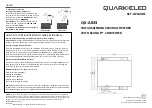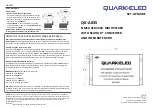
the AC line being measured. Ensure that
the jaws are completely closed and not
making contact with the AC line. For
maximum accuracy it is recommended that
the conductor passes through the centre of
the clamp head opening.
3-4 Apply power to the AC line being measured.
3-5 Read the displayed current.
3-6 If the displayed current is less than 200A,
set the range switch to the next lower range
position. For maximum accuracy select
the lowest range without overranging the
meter.
3-7 Remove power to the AC line and press the
trigger to open transformer jaws to remove
from the circuit.
4 RESISTANCE MEASUREMENT
!
WARNING: Remove all power from
circuit being tested when checking
resistance. Discharge any charged
capacitors. Never connect the probes to
any voltage while the selector is set to
Ω
OHM.
4-1 Plug the red test lead into the V
Ω
jack and
the black test lead into the COM jack.
4-2 Set the range switch to the desired
Ω
setting.
4-3 Attach the test leads to the circuit.
4-4 Read the displayed resistance.
5 CONTINUITY TEST
!
WARNING: Remove all power from
circuit being tested when checking
continuity. Discharge any charged
capacitors. Never connect the probes to
any voltage while the selector is set to
2K
.
5-1 Plug the red test lead into the V
Ω
jack and
the black test lead into the COM jack.
5-2 Set the range switch to the 2K
setting.
5-3 Attach the test leads to the circuit.
5-4 The buzzer will sound when the circuit has
less than 30
Ω
resistance and the measured
resistance value will be displayed.
MEASUREMENTS
Please take a few minutes to read these instruc-
tions and warnings on both sides prior to use.
1 DC VOLTAGE MEASUREMENT
!
WARNING: Maximum input is 600V DC.
1-1 Plug the red test lead into the V
Ω
jack and
the black test lead into the COM jack.
1-2 Set the range switch to the desired DCV
setting. It is best to start with the 600V range
if the voltage is not known.
1-3 Apply the test leads to the circuit to be
measured. Ensure that the black lead is
connected to the negative side of the circuit
and the red lead to the positive.
1-4 Read the displayed voltage.
1-5 If the minus (-) sign appears the voltage is
negative at the point being measured.
2 AC VOLTAGE MEASUREMENT
!
WARNING: Maximum input is 600V AC
(RMS).
2-1 Plug the red test lead into the V
Ω
jack and
the black test lead into the COM jack.
2-2 Set the range switch to the desired ACV
setting. It is best to start with the 600V range
if the voltage is not known.
2-3 Apply the test leads to the circuit to be
measured.
2-4 Read the displayed voltage.
3 AC CURRENT MEASUREMENT
!
WARNING: Do not break or open the AC
line being measured. When measuring
AC current this unit is designed to clamp
around one of the AC lines. Do not leave
clamped for more than 60 seconds. Do
not attempt to measure current using
the test leads.
3-1 Turn off power to AC line being measured.
3-2 Set the range switch to the 600A ACA
current setting.
3-3 Press the trigger to open clamp jaws and
close around one insulated conductor of
SPECIFICATIONS
GENERAL
Display:
3 1/2 digit, 13mm (0.5") H LCD
Maximum Display: 1999
Ranging:
Manual ranging / Autoranging
on Frequency
Polarity:
Automatic, minus (-) sign
indicates for negative polarity
Measuring Rate:
2.5 times/second
Input Impedance: 10 M
Ω
(DCV/ACV)
Operation Temp.: 0 to 45
°
C
Storage Temp.:
-15 to 50
°
C
Power Source:
9V Battery, NEDA 1604 or
IEC 6F22
Dimensions:
82(W) x 192(H) x 33(D)mm
Weight:
270g (including battery)
RANGES AND ACCURACY
DC Voltage:
200V
±
(2.5% + 1)
600V
±
(4% + 1)
(Maximum measurement =
600V)
AC Voltage:
200V
±
(1.5% + 4)
750V
±
(3% + 4)
(Maximum measurement =
600Vrms)
(50 Hz - 500Hz)
AC Current:
200A 50/60 Hz
±
(1.5% + 4)
40-500Hz
±
(3.5% + 5)
20-600A 50/60 Hz
±
(3.5%
+ 4)
40-500Hz
±
(5.5% + 5)
Resistance:
2K-200K
Ω
±
(1.5% + 1)
(Test voltage: 0.3VDC)
Frequency:
2K-20KHz
±
(0.5% + 3)
(Maximum input = 500VDC /
ACrms / Sensitivity: 80Vrms
minimum)
Diode :
Test current: 1.0
±
0.6mA
Test voltage: 3V
OVERLOAD PROTECTION
Voltage:
600VDC / 600 VACrms
Current:
1000A AC for 60 seconds
Resistance:
500VDC / 500VACrms
Frequency:
500VDC / 500VACrms
Diode Test:
500VDC / 500VACrms
6 DIODE TEST
!
WARNING: Remove all power from
circuit being tested when using the diode
check. Discharge any charged capacitors.
Never connect the probes to any voltage
while the selector is set to
.
6-1 Plug the red test lead into the V
Ω
jack and
the black test lead into the COM jack.
6-2 Set the function switch to the
setting.
6-3 Connect the probes to the device you want
to test. Note the meter reading.
6-4 Reverse the probes and note this reading.
6-5 If both values are displaying .OL overrange
the device is open. If both values are very
small the device is shorted. If one reading
indicates .OL overrange and the other
reading is small then the device is good.
7 FREQUENCY MEASUREMENT
!
WARNING: Maximum input is 500 V.
7-1 Plug the red test lead into the V
Ω
jack and
the black test lead into the COM jack.
7-2 Set the function switch to the Hz setting.
7-3 Connect the probes to the point of meas-
urement.
7-4 Read the displayed frequency.
8 BATTERY REPLACEMENT
!
WARNING: Disconnect both test leads
from any equipment before removing
back cover. Do not use meter with case
opened.
8-1 The “
” will appear on the display when
the battery requires replacing.
8-2 Disconnect both test leads and turn off the
power.
8-3 Remove the screw in the small rear cover of
the case and remove the cover.
8-4 Unsnap the battery from the connector and
replace with a new 9V battery.
8-5 Replace the cover and cover screw.




















